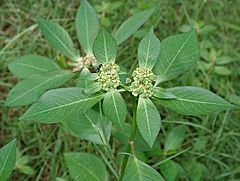Rosids facts for kids
Quick facts for kids Rosids |
|
|---|---|
 |
|
| A beautiful Euphorbia heterophylla plant, which is a type of rosid. | |
| Scientific classification | |
| Kingdom: | |
| (unranked): | |
| (unranked): | |
| (unranked): |
Rosids
|
The rosids are a very large group of flowering plants. Think of them as a big family of plants that share many common features. This group includes about 70,000 different types of species. That's more than a quarter of all the flowering plants on Earth!
Rosids are a major part of the eudicots, which are a huge group of flowering plants known for having two seed leaves when they sprout. Along with another large group called the asterids, rosids make up most of the eudicots.
Contents
What Are Rosids?
Rosids are a special kind of clade. In biology, a clade is a group of organisms that all came from a single common ancestor. So, all rosids are related to each other through a shared plant ancestor.
These plants are found all over the world. They include many familiar trees, shrubs, and herbs. For example, roses, apples, beans, and oaks are all part of the rosid group.
How Are Rosids Grouped?
Scientists organize rosids into smaller groups to understand them better. This large group is divided into 17 main orders. Each order is like a big chapter in a book about plants.
Within these orders, there are about 140 different families. A family is a group of plants that are even more closely related. For example, the rose family (Rosaceae) is one family within the rosids.
When Did Rosids Appear?
We know that rosids have been around for a very long time. Scientists have found fossils of rosids that date back to the Cretaceous period. This was the time when dinosaurs still roamed the Earth!
Using special methods, scientists estimate that the first rosids appeared between 125 and 99.6 million years ago. This means they are an ancient and very successful group of plants.
How Scientists Study Rosids
Scientists use different ways to study and classify rosids. Sometimes, they look at the physical features of the plants. Other times, they use molecular biology to study their DNA.
Because of these different methods, there can be slight differences in how scientists define the rosid group. For example, some scientists include a plant order called Saxifragales in the rosids, while others do not. This shows how science is always growing and changing as we learn more!
See also
- In Spanish: Rósidas para niños

